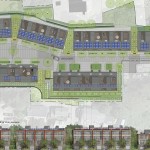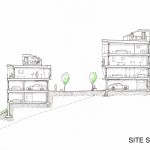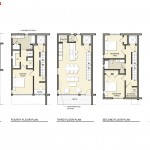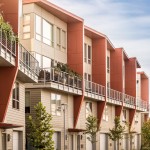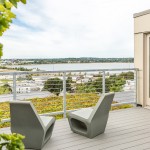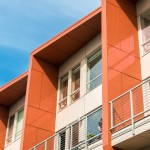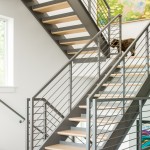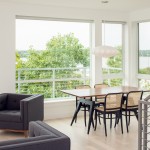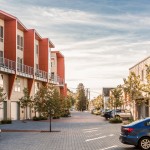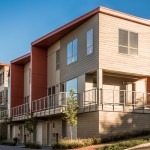Munjoy Heights
Project Name
Munjoy Heights is a 29 unit residential project perched upon Munjoy Hill in Portland’s East End. When we first walked the site the design problem was quite apparent, the grades were very steep with only a five foot wide level path along the cross slope. We peered through the thick undergrowth to a spectacular view to Back Cove and the mountains beyond. The question we left with that day was ‘How could a building design capture the wonderful views and daylight that exist on a site with virtually no level surface?’. The solution was a multidiscipline coordinated effort that blurred the lines between building and site. The sixty foot elevation change across the site was handled in multiple steps to terrace the buildings down the hill. The uphill buildings are backed by a retaining wall to make up one story of grade and their garage level foundations then transition another story. The common access to the uphill and downhill buildings is via a shared use courtyard or ‘Woonerf’. The downhill buildings make up another story of grade with their foundations.
Although we knew this design challenge would require a complex design and engineering solution we utilized the site elevation change to our advantage and provided five stories of glass wall views to Back Cove and the mountains in the distance.
The linear site with linear buildings created a design challenge of how to give each building scale and each residential unit its own definition. Our first instinct was to create a vertical proportion by utilizing contrasting projected elements to contain each residential unit. This element evolved into both a functional and aesthetic gesture that we expanded upon and makes the design more impactful and meaningful. The gesture is a terra-cotta colored ribbon that leads your eye into the project from Walnut Street, this ribbon starts at the unit entries and canopies and runs up the facades and across the roof edge containing each unit. Within the ribbon we composed a pattern of flat siding panels and horizontal siding that work with the fenestration to hold larger edges and shapes on the facades. We learned much through the evolution of the buildings’ designs and like to think the end result is that of building(s) with ‘perceived active facades‘ that create a sense of flowing energy and motion a person walking down the ‘Woonerf’ will experience.
Sustainability Highlights: Passive solar design, building orientation to maximize solar gain with overhangs for shading, Super-insulated building envelope R-86 Roof, R-32 Walls, High efficiency air to air HVAC systems, Energy Recovery Ventilation System, LED lighting, Low Flow plumbing fixtures, Pre-Wired for rooftop Photovoltaic systems, elimination of existing invasive plant species, replanted with native plant species, edible plantings for natural habitat for birds and animals. On site storm water treatment below pervious paving system.

